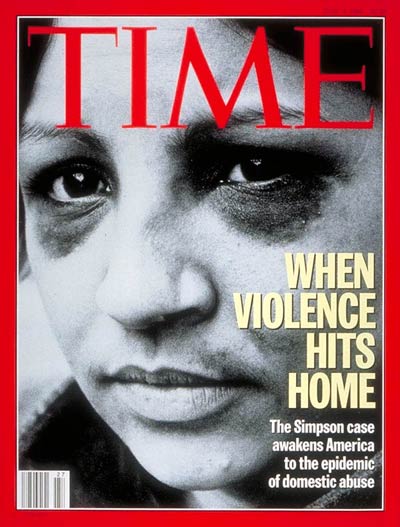
Two weeks after football star O.J. Simpson was arrested for the murder of his wife Nicole Brown Simpson, TIME ran a cover story called “When Violence Hits Home.” Twenty years later, Ray Rice was suspended from the NFL after he was caught on video punching his wife Janay in an elevator, and we’re again embroiled in a national discussion of domestic violence.
So what’s the difference between two football stars, two battered wives, 20 years apart? The O.J. Simpson case helped the country wake up and acknowledge that domestic violence is a problem (even after he was acquitted of murder), while the Ray Rice incident forces us to decide how much we are willing to tolerate it.
TIME’s July 1994 cover story was written with a hushed tone, as if the trove of evidence about domestic violence were a secret trunk in a spooky attic. Jill Smolowe wrote:
The horror has always been with us, a persistent secret, silent and pernicious, intimate and brutal. Now, however, as a result of the Simpson drama, Americans are confronting the ferocious violence that may erupt when love runs awry.
Today, now that the cat’s been out of the bag for two decades, the discussion about domestic violence is louder, angrier and less willing to accept that it’s a “private” matter.
Twenty years after O.J., few Americans can say they don’t know what domestic violence means. Simpson’s trial was one of the most-watched in history, and the raised awareness helped pass the Violence Against Women Act, which then-Senator Joe Biden pushed through the Senate with a mere 61 votes. It was signed 20 years ago this week. “Some of the controversy at that time was about whether or not the federal government should play a role in an issue that many people regarded as a ‘family matter,'” said Congresswoman Donna F. Edwards (D-Maryland), who co-founded the National Network to End Domestic Violence and worked to pass VAWA before she took office in 2008. “Nowadays, I think the majority of Americans recognize that domestic violence is a crime.”
The O.J. trial was also a watershed moment for understanding the connection between domestic abuse and murder. Before the Simpson murders, few Americans understood that men who beat women sometimes become men who kill women. (Although there are male victims and female perpetrators, the vast majority of domestic violence is man-on-woman.) Two years later, in 1996, Congress passed a law preventing domestic batterers from purchasing guns, and by 2008 domestic homicide rates had plummeted 53%, according to the Department of Justice.
Most of TIME’s 1994 cover story feels remarkably current; the psychology of violence, the cycles of abuse, the terrified victims reluctant to speak up are all consistent with what we now know to be true about domestic violence. But while the pathology remains the same, the reaction has changed.
For one thing, this week’s Ray Rice incident is less about raising awareness and more about the public demanding retribution. Experts say the reaction to the elevator beating is much stronger than anything they’ve seen before. “We didn’t see this kind of outrage over when that happened with Chris Brown and Rihanna,” says Katie Ray-Jones, president of the National Domestic Violence Hotline. “Back then, we still heard a lot of comments saying ‘we don’t know what happened in that car,’ and our hotlines were flooded with Chris Brown fans supporting him.”
“The Ray Rice video really gave a face to the issue — we throw a lot of statistics out there in the field about ‘1 in 5 women,’ ‘1 in 7 men’ but when you see a video like that, you say, ‘Oh my goodness, that is outrageous,'” Ray-Jones says. She also adds that calls to the hotline have gone up 84% since the video leaked Monday.
Another major difference between O.J. and Ray Rice is that 20 years ago there was no Internet, and now it’s everywhere.
It’s true that when it comes to partner abuse, technological advances can cut both ways. While social media provides a valuable outlet for survivor support, and the Internet helps victims learn about resources they can use to escape, Ray-Jones says “technology can be a victim’s friend or it can be her enemy.” That’s because abusers are using GPS in their victims’ phones to track where they are, or using spyware to monitor whether their partner is reaching out for help, or threatening violent consequences if text messages aren’t immediately returned. “Technology allows survivors to feel empowered and to get her voice out in the conversation,” Ray-Jones said. “But there are a lot of ways people are using technology to further control an individual.”
Still, If this were 1994, the video of Rice beating Janay that was leaked to TMZ might not have ever been released. And social media allows ordinary Americans to make their voices heard, which means that abuse has major consequences outside of the legal system. Ray Rice was canned from the NFL, and some are calling for commissioner Roger Goodell to be next. The story has dominated Twitter and Facebook, spawning victim-driven hashtags like #whyIstayed and #whyIleft. Thanks to technology, there are now major social and professional consequences for hitting your girlfriend, where once there were only legal ones. It was always wrong; now it’s also bad PR.
Read the 1994 cover story on domestic violence here, in TIME’s archives: When Violence Hits Home
More Must-Reads from TIME
- Cybersecurity Experts Are Sounding the Alarm on DOGE
- Meet the 2025 Women of the Year
- The Harsh Truth About Disability Inclusion
- Why Do More Young Adults Have Cancer?
- Colman Domingo Leads With Radical Love
- How to Get Better at Doing Things Alone
- Michelle Zauner Stares Down the Darkness
Write to Charlotte Alter at charlotte.alter@time.com